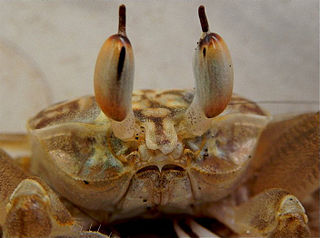
Ocypode brevicornis is a species of ghost crab native to the Indian Ocean, from the Gulf of Oman to the Nicobar Islands. They are relatively large ghost crabs with a somewhat trapezoidal body. The carapace reaches a length of 41 mm (1.6 in) and a width of 50 mm (2.0 in). They are a mottled brown to yellow in coloration. Like other ghost crabs, one of their claws is much larger than the other. Their eyestalks are large and elongated, tipped with prolongations at the tip known as styles. They are common inhabitants of open sandy beaches, living in burrows in the intertidal zone.

Electrostephanus is an extinct genus of crown wasp in the hymenopteran family Stephanidae, and is the only genus placed in the subfamily Electrostephaninae. The genus contains four described species, E. brevicornis, E. neovenatus, E. janzeni, and E. petiolatus, placed in two subgenera E. (Electrostephanus) and E. (Electrostephanodes). Electrostephanus is known from several middle Eocene fossils which have been found in Europe.

Homonoeini is a tribe of longhorn beetles of the Lamiinae subfamily. It was described by Thomson in 1864.
Bumetopia is a genus of longhorn beetles of the subfamily Lamiinae, containing the following species:

Bumetopia intermedia is a species of beetle in the family Cerambycidae. It was described by Stephan von Breuning in 1947. It is known from the Philippines.
Bumetopia ohshimana is a species of beetle in the family Cerambycidae. It was described by Stephan von Breuning in 1939.
Bumetopia schultzei is a species of beetle in the family Cerambycidae. It was described by Stephan von Breuning in 1950. It is known from the Philippines.
Bumetopia uniformis is a species of beetle in the family Cerambycidae. It was described by Stephan von Breuning in 1939. It is known from the Philippines.
Bumetopia aliena is a species of beetle in the family Cerambycidae. It was described by Newman in 1842. It is known from the Philippines.
Bumetopia bakeri is a species of beetle in the family Cerambycidae. It was described by Per Olof Christopher Aurivillius in 1927 and is known from the Philippines.

Bumetopia bilinea is a species of beetle in the family Cerambycidae. It was described by Newman in 1842. It is known from the Philippines.
Bumetopia conspersa is a species of beetle in the family Cerambycidae. It was described by Per Olof Christopher Aurivillius in 1924 and is known from the Philippines.
Bumetopia flavovariegata is a species of beetle in the family Cerambycidae. It was described by Per Olof Christopher Aurivillius in 1911.
Bumetopia fornicata is a species of beetle in the family Cerambycidae. It was described by Newman in 1842. It is known from the Philippines.
Bumetopia japonica is a species of beetle in the family Cerambycidae. It was described by Thomson in 1868.
Bumetopia oscitans is a species of beetle in the family Cerambycidae. It was described by Francis Polkinghorne Pascoe in 1858.
Bumetopia sakishimana is a species of beetle in the family Cerambycidae. It was described by Hayashi in 1966.
Bumetopia stolata is a species of beetle in the family Cerambycidae. It was described by Masaki Matsushita in 1931. It is known from Taiwan.
Bumetopia yagii is a species of beetle in the family Cerambycidae. It was described by Masao Hayashi in 1994.
Bumetopia trigonocephala is a species of beetle in the family Cerambycidae. It was described by Heller in 1923. It is known from the Philippines.






